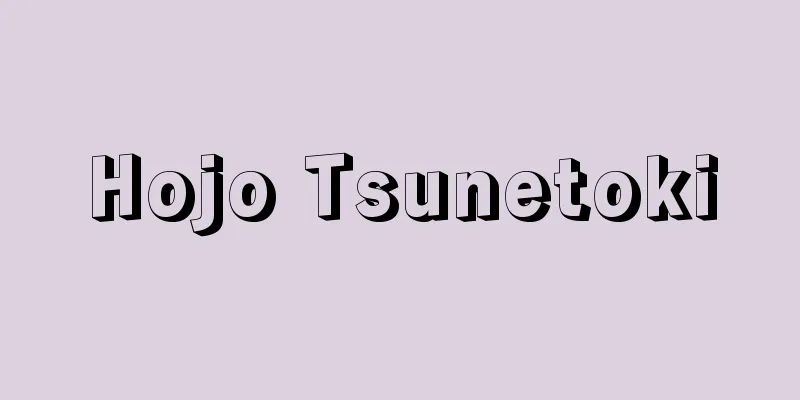Czechoslovakia - Czechoslovakia (English spelling)

|
A country that existed in the center of Europe. From 1969 to 1992, it was a federal system of two republics: the Czech Republic, made up of Slavic Czechs, and the Slovak Republic, made up of Slovaks. Its official name was the Czechoslovak Republic from 1918 to 1960, the Czechoslovak Socialist Republic from 1960 to 1990, and the Czech and Slovak Federal Republic from 1990 to 1992. Its area is 127,896 square kilometers, and its population in 1991 before it split into the Czech Republic and Slovakia was 15,583,000. Its capital is Prague. Its national flag is a red, blue and white tricolor. Slovakia was under Hungary's control for many years, while the Czech Republic was part of Austria in the early modern period, and was the most prosperous country in medieval Europe. After World War I, the two countries formed the independent state of Czechoslovakia, and in 1948 after World War II, the Communist Party took power, and it became a socialist republic with the 1960 constitution. As reforms progressed in Eastern Europe, the federation was dissolved on December 31, 1992, and the country split into the Czech Republic and Slovakia. The country is compact, stretching 647 km from east to west and 273 km from north to south, and borders Poland, the former Soviet Union, Hungary, the former East Germany, the former West Germany, and Austria. The longest border is with Poland, which accounts for about two-fifths of the country's total length. Located on the border between the East and West of the world, Czechoslovakia is a landlocked country without a sea border. The country, which was made up of the Czech Republic and Slovakia, is further divided into Czech Republic (Bohemia) and Moravia, and Slovakia into East Slovakia and West Slovakia. The area of the Czech Republic and Slovakia is 62:38, but the population is 66:34 (1991). In addition, the total industrial production is 4:1, and the total agricultural production is 68:32, with the Czech Republic being an economically developed industrial country and Slovakia having a high agricultural share. In terms of tourism, Prague, the "city of a hundred towers," is the number one, and there are many attractive cities throughout Czechoslovakia that attract tourists. Examples include Cesky Krumlov in southern Czech Republic, which is registered as a World Heritage Site, Mikulov in Moravia, and Martin in Slovakia. Karlovy Vary and Mariánke Lazne are also famous for their mineral springs and resort towns. On the other hand, the beautiful natural scenery of various regions is also a tourist resource, and mountain sightseeing trips have also developed. The Krušíne Hory Mountains in northwestern Czech Republic and the High Tatra Mountains in Slovakia, known as the Czechoslovakian Alps, are representative examples. The Moravian hills and the rural areas of southern Czech Republic are also known for their beautiful scenery. [Taizo Nakamura] NatureTopography and ClimateIn the west, the Czech Massif (also called the Bohemian Massif or Bohemian Basin), a square formed by the Hercynian orogeny, 200 km on each side, is bounded on three sides by mountain ranges of moderate altitude - the Šumava Mountains and the Bohemian Forest (Český Les) in the southwest, the Krušíne Hory (Erzgebirge) in the northwest, and the Sudetic Mountains in the north and northeast - and continues to the Czech Moravian Upland (500-600 m above sea level) in the east and southeast. The Czech Massif is a rugged area with hills, river lowlands and mountains. Moravia is hilly and lowland in the central and southern parts, except for the northern mountainous region (Sudety), while Slovakia is mostly mountainous. The Carpathian Mountains, formed by the Alpine orogeny, run through the country, with an altitude of 1,000 to 1,500 meters, and in the center lies the highest Tatra Mountains, formed of crystalline rocks, with the highest peak being Mount Gerlachovski (2,663 meters). The Danube Plain and parts of the Tisza Plain spread out in the south and east. The pass between the Morava River, a tributary of the Danube that flows between the western Beskid Mountains and the northeastern Czech Republic, and the upper reaches of the Odra (Oder) River, is called the "Morava Gate" and has been a key transportation point connecting the Baltic Sea and the Adriatic Sea since ancient times. The climate is mild continental in most of the country. Winter temperatures are -2 to -4°C, and summer temperatures are 13 to 21°C. In general, the continental climate becomes stronger from west to east, with summers being hot in the Tisza and Danube plains. The national average annual precipitation is just over 700 mm, with most of it in the summer. Winters are generally dry. On flat land below 200 meters above sea level, about 10% of the annual precipitation is snow. Winds are mostly westerly or southwesterly, blowing at speeds of 2 to 3 meters per second. [Taizo Nakamura] Rivers and vegetationThe country has a relatively dense river network, with the main rivers being the Labe (Elbe), Vltava (Moldau), Odra and Danube. All of the rivers except the Danube originate in the country, which is why Czechoslovakia is the main watershed of Europe and is called the "Little Roof of Europe". Only the Danube and Labe are navigable, but the Labe freezes over for 50 to 60 days a year and the Danube freezes over for 30 days. The vegetation is mainly steppe up to 300 meters above sea level, and changes successively to broadleaf (oak, beech) forest, mixed forest, and coniferous forest as you move upwards. Forests cover one third of the country's land area, and are dominated by fir trees. The main underground resources are coal, lignite, lead, zinc, uranium, and porcelain clay (clay for porcelain), but mineral reserves are not large. However, there are mineral springs in various places. [Taizo Nakamura] historyUntil World War IThe Western Slavs, who are called Czechs and Slovaks, settled in the present region around the 6th century AD. The Germanic peoples who came to this region after the indigenous Celts migrated south during the "Migration of Peoples" period, leaving the area vacant. The Western Slavs were later attacked by the nomadic Avars, but the Frankish merchant Samo established the Samo Kingdom, which became independent from the Avars (7th century). In the early 9th century, the Western Slavs established the Great Moravian State in this area to counter the Frankish Kingdom's domination of the east, and strengthened its ties with the Byzantine (medieval Greek) world, but it was destroyed by an attack from the Hungarians in the early 10th century. The Western Slavs who came under Hungarian rule here formed the Slovaks, and were cut off from the Czechs who had formed in the west. They were forced to enter separate cultural spheres until the two formed a unified state in the 20th century. Czechs united under the House of Přemysl in the Czech Republic, which consisted of Bohemia and Moravia, and began to form their own nation. Successive kings and princes actively introduced Christianity (Roman Catholicism) to defend against Germany's eastward advance and to establish a monarchy within the country, and swore allegiance to the Holy Roman Emperor. The Czech region was rich in precious metals, and with its economic power it rose in the empire, and Bohemia was even recognized as a kingdom by the emperor after the second half of the 12th century. Meanwhile, Moravia was subordinate to Bohemia as a margraviate. From the 13th century onwards, the migration of German citizens and farmers to the Czech Republic became more active, and the king also welcomed immigrants as part of his financial policy, encouraging the construction of cities and the development of mines and granting them many privileges. This policy of protecting Germans was an indirect cause of ethnic problems in the country. Czech economic, cultural and political development in the Middle Ages took place under the House of Luxembourg in the 14th century. The reign of Charles I (Charles IV), King of Bohemia, who was elected Holy Roman Emperor, was the most glorious period in Czech history. He established the principle of monarchy with the issuance of the Golden Bull (1356) and strengthened the German territorial status, while at the same time demonstrating Czech power both at home and abroad by making Prague the capital of the empire, founding the first university in the German world (Charles University) there, establishing an archbishopric there, and building new city districts. This prosperity of Czechoslovakia was parallel to the promotion of Germanization, with many of the ruling class being German, and the influential German citizens of the city having strong ties to the German economy, incorporating Czechoslovakia into the German commercial sphere. This momentum of Germanization eventually caused an ethnic backlash, and ethnic conflict became apparent with the Hussite Reformation and the subsequent Hussite Wars. In the 16th century, the Czech Republic formed a joint anti-Turkish alliance with Hungary and Austria, but it was the Austrian Habsburgs who took the lead. The conflict between the Czech Republic and Austria took place under the influence of the Protestant Reformation in Eastern Europe. The Thirty Years' War (1618-1648) was triggered by the rebellion of Czech Protestant nobles against the centralist policies of the Habsburgs. Bohemia was repeatedly turned into a battlefield in wars between Catholics and New Christians, causing a sharp decline in the population and the devastation of farmland. As a result of this war, the Czech Republic became a vassal state of the Habsburgs, and ethnic and territorial independence was prevented. Germanization spread throughout the country, ushering in the so-called "Dark Ages" (Temno). However, from the end of the 17th century, signs of economic recovery began to appear in the Czech Republic, and the 18th century saw a dramatic development in the textile industry. The Enlightenment and German Romanticism movements of the 18th century contributed greatly to stimulating interest in the origins and national cultures of various ethnic groups. Young Slovak intellectuals studying in Germany at the time were strongly influenced by Herder's ideas and German Romanticism, and became standard-bearers of the Slavic national awakening. The Slovak Kolar established the foundations of cultural pan-Slavism, and Štul created the Slovak literary language. The Czech Palacký wrote "The History of the Czech People." For these leaders of the Czech and Slovak national movement, the 1848 Revolution that swept across Europe was a turning point. In the same year, the Slavic National Congress, consisting mainly of Slavs living in the Austrian Empire, was held in Prague, and in the midst of the chaotic political situation, a proposal was made to reorganize Austria into an ethnic federation. However, in 1867, the Austrian government suppressed the demands of the Czechs, made a "compromise" (Ausgleich) with Hungary, and established the Austro-Hungarian Dual Monarchy. This led the Czechs to take the lead among the ethnic groups who were dissatisfied with the "compromise." The background to this was the remarkable economic development of the food and machinery industries, and in 1867 a bank with Czech ethnic capital was established. Therefore, the Austrian government could not ignore the demands of the Czech bourgeoisie, which were based on the development of ethnic capital, and issued a language decree (Taaffe Language Decree, Badeni Language Decree) that required all government officials living in the Czech Republic to use both Czech and German, demonstrating a policy of appeasement for the Czechs. The rise of the Czechs in this way intensified ethnic conflicts due to the growth of the working class with the development of capitalism, and spread the struggle to the everyday level of the general public. On the other hand, the Slovaks, who had been ethnically divided and ruled separately from the Czechs for a long time, also sought independence from Hungary through a nationalistic movement in the second half of the 19th century, but because of their economic backwardness, the movement was limited to cultural activities, and political demands were suppressed by the Hungarians. On the eve of World War I, there was no movement for independence in the Czech Republic, and the mainstream movement was to obtain autonomy or a federal system within the framework of the empire. [Tsuyoshi Inano] After World War IWhen World War I broke out, many Czech and Slovak leaders watched the situation calmly, but the famous philosopher T. G. Masaryk and others organized the Czechoslovak independence movement based in Paris. During the independence movement, the Czechoslovak Legion organized in Russia came into military conflict with the Soviet government in May 1918, and Japan, the United States, and others sent troops to Siberia under the pretext of rescuing the Czechoslovak Legion. This incident triggered the movement led by Masaryk and others to receive support from the Allies in the latter half of the same year, and even among Czech leaders who remained in the country, the movement for independence in response to the movement abroad grew stronger, and cooperation between Czech and Slovak leaders also progressed. On October 28 of the same year, Czech leaders declared independence in Prague, and on the 30th of the same month, Slovak leaders also declared that Slovakia would form a unified state with the Czech Republic. On November 14, the Czechoslovak Republic was established, Masaryk was elected as its first president by the Provisional National Assembly, and a government was formed with K. Kramash as prime minister. The new state was a multi-ethnic state with a population of 13.37 million (1921), of which 8.76 million (65.5%) were Czechs and Slovaks, 3.12 million (23.4%) were Germans, 750,000 (5.6%) were Hungarians, 460,000 (3.5%) were Ukrainians and Russians, and others (such as Poles and Jews). The Czechs, who gained the upper hand in the process of building the new state, suppressed demands from Slovaks and others for the introduction of a federal system, and a centralized state system was adopted in the constitution enacted in February 1920. Proportional representation elections were used in the parliament, and it was divided into small parties reflecting the complex ethnic composition of the country, but a coalition government centered on the Farmers' Party continued, and parliamentary democracy did not cease to function as it did in other Eastern European countries. In the second half of the 1920s, some of the German parties, which had been negative about the new republic, also began to join the coalition government. The economy was also in turmoil immediately after independence, but stabilized in the second half of the 1920s. The Slovak People's Party led by A. Hlinka and the German parties sought autonomy and criticized the centralized state system. In the 1930s, unemployment increased due to the Great Depression, and when Hitler came to power in Germany in 1933, the international environment surrounding Czechoslovakia also became unstable. In the 1935 election, the Sudeten German Party became the largest German party. The party initially demanded autonomy, but later joined forces with Nazi Germany and demanded the annexation of the Sudetenland, an area inhabited by Germans, to Germany. At the Munich Conference in September 1938, the leaders of Britain, France, Germany, and Italy agreed to the annexation of the Sudetenland by Germany, and the Czechoslovak government accepted this agreement. In October, the Sudetenland was annexed, and Poland and Hungary also annexed other territories. Furthermore, Slovakia's demand for autonomy was also accepted, and Czechoslovakia became a federal state. In March 1939, Germany annexed the entire Czech Republic as a protectorate, and Slovakia became independent as a German protectorate. [Tadayuki Hayashi] Post-World War II: PoliticsE. Beneš, who succeeded Masaryk as president in 1935, resigned and went into exile after accepting the Munich Agreement. After the outbreak of World War II, Beneš organized a government in exile in London. Resistance movements continued in the country under difficult circumstances, and in August 1944 a national uprising broke out in Slovakia, in which some of the Slovak National Army participated, but was suppressed by the German army in October (Slovak National Uprising). The London government in exile concluded a Treaty of Friendship, Mutual Assistance and Postwar Cooperation with the Soviet Union in December 1943, and also drew up an agreement on a postwar government with the Czechoslovak Communist Party, which was in exile in Moscow. In April 1945, the Soviet army announced the National Front Government Platform (Košice Platform), and a coalition government was formed based on it. After the liberation of Prague in May, the government returned to the capital. In accordance with the Košice Program, the coalition government embarked on postwar reforms such as the nationalization of large companies. In addition, with the agreement of the Allied Powers, ethnic German residents were expelled from the country, but this meant that war responsibility was placed on all Germans living in the Czech Republic, and debate continued on whether this was appropriate. Parliamentary elections were held in May 1946, in which the Communist Party emerged as the largest party, but the coalition government remained in power. However, conflict between the left and right within the government gradually intensified, and in February 1948 the Communist Party launched a large-scale mass mobilization, and President Beneš approved the establishment of a new government in which the Communist Party would take the lead. A new constitution was enacted in May of the same year, and Gottwald of the Communist Party became president in place of Beneš. Thus, the Communist Party's rule in Czechoslovakia was complete, but a series of purges were carried out within the party from 1949 to 1951, and many people were imprisoned or executed. Even after the 1948 Constitution was enacted, the country's name was still the same as before, "Czechoslovak Republic", but in the 1960 constitutional amendment it was changed to "Czechoslovak Socialist Republic Československá Socialistická Republika". De-Stalinization in Czechoslovakia was slower than in other countries, and it was not until the 1960s that the honor of the victims of the purges began to be restored. In the late 1960s, a series of economic reforms were proposed to break the economic stagnation, but they were not realized due to resistance from conservatives. However, in 1967, demands for democratization increased both within and outside the Communist Party, and criticism of Novotny, who served as both president and first secretary of the party, erupted. In January 1968, A. Dubcek became First Secretary of the Party, and in March, L. Svoboda became President. In April of the same year, the Plenum of the Central Committee of the Communist Party adopted the "Platform for Action", and a series of democratization policies known as the "Prague Spring" were implemented. However, this attempt at reform came to an end with the invasion of the Warsaw Pact forces in August (see "Czech Incident"). In April 1969, G. Husák became First Secretary (later Secretary General), and after that, a "normalization policy" was implemented, and a certain degree of economic stability was seen in the 1970s. During the "Prague Spring," discussions on federalism progressed. After military intervention, a bill to amend the constitution was passed by parliament in October 1968, and a federal system was introduced in January 1969. The Czechoslovak Socialist Republic became a federal state consisting of the Czech Socialist Republic and the Slovak Socialist Republic, and each of the two federal republics established its own parliament and government. The federal parliament was composed of the House of Peoples and the House of Nationalities, with the former allocated seats in proportion to the population, and the latter allocated an equal number of seats to both republics. In addition, in order to correct the economic disparity between the two republics, focused investment continued in Slovakia, promoting industrialization there. Intellectuals continued to criticize the system even after the military intervention, and in 1977 "Charter 77" was published, attracting international attention, but the authorities severely suppressed it, and the movement remained isolated amid the political apathy of the people. In the second half of the 1980s, reforms known as perestroika progressed in the Soviet Union, and communist governments in Poland and Hungary also promoted economic reforms, but the conservative leadership of the Czechoslovak Communist Party maintained a cautious stance toward reform. In September 1989, a government led by the independent trade union Solidarity was inaugurated in Poland, in October the principle of the Communist Party's leadership was abandoned in Hungary, and on November 9th the East-West border in Germany was opened. Under these circumstances, in Czechoslovakia as well, a large-scale movement demanding democratization spread throughout the country, starting with a student demonstration in Prague on November 17th, and on the 29th of that month, the federal parliament deleted the constitutional clause that stipulated the leading role of the Communist Party. In December, a government of national reconciliation was formed, which included the previous opposition forces, and Vladimir Havel, a playwright and renowned anti-establishment figure, was inaugurated as president. National elections were held in June 1990, and the Czech Republic's Civic Forum, Slovakia's Public Against Violence, and the Christian Democratic Movement, which held a majority in the federal parliament, formed a federal coalition government and began a full-scale economic transition, including privatizing companies and liberalizing prices. Immediately after the collapse of the Communist regime, conflict between Czechs and Slovaks over the new name of the country became apparent, but in April 1990 a compromise was reached on the new name "Czech and Slovak Federal Republic Česká a Slovenská Federativní (Slovak: Federatívna) Republika". However, the Slovak side opposed the radical economic transition policy led by Czech economic experts, and in tandem with this, the conflict over the form of the federal system gradually intensified. In the election held in June 1992, right-wing parties that supported maintaining strong authority for the federal government and a radical economic transition policy won in the Czech Republic, while nationalists who wanted a gradual reorganization into a confederation of states and a gradual economic transition policy won in Slovakia, making it difficult to maintain a unified state. After a series of meetings between V. Klaus, leader of the Civic Democratic Party, the largest party in the Czech Republic (later to become Prime Minister of the Czech Republic), and V. Mečiar, leader of the Movement for Democratic Slovakia, the largest party in Slovakia (later to become Prime Minister of the Slovak Republic), the dissolution of the federation was agreed upon, and after a series of legal reforms, the Czechoslovak state ceased to exist at the end of 1992, and the Czech Republic and the Slovak Republic became independent as sovereign states on January 1, 1993. [Tadayuki Hayashi] Economy and IndustryOverviewCzechoslovakia had already developed its industry before the Second World War, and after joining the socialist bloc after the Second World War, it further developed its industry and promoted the heavy and chemical industrialization. Although the country had developed industry on a par with the developed Western countries, the share of agriculture and forestry in the total national income produced was less than 10%. The socialization of industry was almost completed in the 1940s in the industrial sector and in the 1950s in the agricultural sector. Production was most developed in the 1950s, but the growth rate declined as the years went on through the 1960s and 1970s. During the Sixth Five-Year Plan (1976-1980), the planning system was partially revised to increase economic growth, but the planning targets for this period were not achieved, and the average annual growth rate of national income was only 3.7%, instead of the 4.9% expected in the Sixth Five-Year Plan. [Taizo Nakamura] From 1983 until the separation of the Czech Republic and Slovakia at the end of 1992Since the Prague Spring was suppressed by the military force of the Comecon countries, Czechoslovakia has firmly maintained its socialist economic system and has also turned its back on the Polish Solidarity movement. The pace of economic growth was stagnant and only slightly increasing until the end of 1989, when the Berlin Wall fell and the Communist government resigned. In 1990, the parliament adopted a course of economic reform. This was a radical reform known as "shock therapy," and aimed to implement austerity measures, tax reform, privatization, price liberalization, and reform of the industrial structure. This caused a rapid decline in production and inflation in the Czechoslovak economy from 1990 to 1992. Gross domestic product fell by -1.6% in 1990, -14.7% in 1991, and -7.0% in 1992 compared to the previous year, while industrial production fell by -3.7% in 1990, -23.5% in 1991, and -16.7% in 1992, and the inflation rate was 10.0% in 1990, 57.8% in 1991, and 10.8% in 1992 compared to the previous year. However, compared to other former Eastern European countries, the inflation rate was low, and was only significant in 1991. Most commodity prices were liberalized, and privatization, which began with the privatization of small state-owned enterprises, began in 1991 with the privatization of larger enterprises as well, so that by the end of 1992 private enterprises accounted for more than one-fifth of gross domestic product. One of the main reasons why the economy did not experience much of a decline was the increase in exports to Western countries. During the time of joining COMECON, exports and imports with COMECON countries, including the Soviet Union, accounted for around three-quarters of total exports and imports at their peak, but by 1992 this had fallen to less than a quarter, and trade with the EC fell to around half. [Taizo Nakamura] industryAgriculture in Czechoslovakia was intensive, and its level was said to be second only to East Germany in Eastern Europe. Farms were also integrated and large-scale, and mechanization was progressing. Livestock farming was the main focus, with crop cultivation secondary, and the area cultivated for potatoes and some industrial crops, which require a lot of labor, was decreasing. The proportion of people working in agriculture among the total number of employed people had fallen from approximately 40% in 1950 to 11.4% in 1991, and the high rate of agricultural population outflow and the aging of the agricultural workforce were impeding development. In industry, the socialist government's priority policy gave heavy chemical industry a high weight, while the food and textile industries had a low weight. With the exception of coal and lignite, underground resources were scarce, and the country was heavily dependent on coal and lignite, which accounted for nearly two-thirds of energy production, but there was an increasing dependency on oil and natural gas imported from the Soviet Union. Nevertheless, the chemical industry developed significantly, and production of synthetic rubber, plastics, synthetic fibers, nitrogen fertilizer, etc. increased, and the raw materials for these were supplied from the lignite fields in the west and the Ostrava coalfields in the center, as well as imported oil and natural gas. The value of trade has increased six-fold in the 20 years since 1960. In 1992, imports per capita were $797 and exports $741. The main export items were machinery, automobiles, iron and steel, railway cars, textiles and clothing, while the main import items were machinery, petroleum products, automobiles, iron and steel/iron ore, and textile raw materials (1989). [Taizo Nakamura] societyPeople and LanguageThe main ethnic groups in Czechoslovakia were Czechs and Slovaks, who accounted for approximately 62.9% and 31.8% of the total population (1992). In terms of language, Czech and Slovak belong to the same West Slavic language group and are very closely related. Before World War II, the Czechs and Slovaks were officially considered to be one people. However, in reality, the Czechs, who had an advantage in economic development and education, came to dominate the Slovaks. The Slovaks, who rebelled against the centralization policies of the Czechs, demanded autonomy and came into conflict with the Czechs. Even after the war, it cannot be said that the conflict between the two ethnic groups was immediately resolved, but the adoption of a federal system in 1969 can be said to have reached a tentative conclusion to this issue. The federal government also actively invested in Slovakia, aiming to eliminate the economic disparity between the two republics. In Czechoslovakia, both Czech and Slovak were used in public life, but the two languages were so closely related that they could understand each other, so that national television alternated between Czech and Slovak depending on the program, and educational and publishing activities were also carried out in the Czech and Slovak languages. As for ethnic minorities, their numbers were greatly reduced after World War II, when many Germans were expelled for collaborating with the Nazis and most of the Ukrainian-inhabited areas were incorporated into the Soviet Union. However, a significant number of Hungarians (approximately 585,000 in 1982) remained, mainly in southern Slovakia, and their right to education in their own language was recognized. [Tadayuki Hayashi] National LifeAccording to data from before the breakup of the federation, the population density was 122 people per square kilometer (1991), and the natural population growth rate was low at 1 person per 1,000 people (1990) (average 0.2% from 1990 to 1992), a problem that was taken seriously due to a labor shortage. The average life expectancy was 67.6 years for men and 75.2 years for women. The standard of living was 412 televisions and 223 cars per 1,000 people, the second highest after East Germany (both in 1990). Czechoslovakia was a socialist country, so in principle there was no problem with unemployment. Rather, the major problem was the labor shortage, and as a result, the proportion of women in the workplace was very high. There was also a serious labor shortage in rural areas during the harvest season, so students and soldiers went there every year to help out. The education system was in three stages, with primary education being compulsory for 9 years from the age of six, secondary education being three years high schools (Gymnasium) and various vocational high schools, and universities (in principle five years) above them. Because the employment rate of women was high, the education system for early childhood before compulsory education was well established, and the education system for people with physical disabilities was also well established. In addition, there were many nighttime foreign language schools aimed at working people, and universities were also open to working people. In addition, there was a focus on youth education activities by organizations other than schools, and the group activities at the Youth Socialist Alliance and Pioner were particularly important. In terms of welfare, all medical care was free, and there were many doctors. In the late 1980s, 32.3 people per 10,000 people (16.4 in Japan), and hospital beds were 79 for 10,000 people. Medical care was especially provided for pregnant women and infants, with the death rate for infants up to the first year of life at 13 per 1,000. Pensions were received from men aged 60 and women aged 53-57 (depending on the number of children raised), and miners and participants in the wartime resistance campaign were given additional preferential treatment. The constitution cited freedom of religion, but religious activities were roughly under the control of the state. The relationship between the church and the state was stipulated in many laws, and the state was responsible for the expenses required by each church (including education for clergy, maintenance and repair of buildings, etc.). [Tadayuki Hayashi] "The Truth About the Czech Economy by Ota Sik, translated by Hayashi Saburo (Mainichi Shimbun, 1970)" ▽ "World Geography 8: Europe III" (1975)" ▽ "F. Fate, translated by Kumada Toru, Eastern Europe after Stalin" (1978)" ▽ "World Geography Seminar III" (1980)" ▽ "World Geography Seminar III" (1980) " ▽ "Goi Kazuo and Nojiri Taketoshi, Economy of the Soviet Union and Eastern Europe (1981)" ▽ "L. Straszewich, translated by Tanioka Hideo, New Situations of Eastern Europe (1982 Sanseido)" ▽ "Kido Tsuyoshi, Politics and International Relations of Eastern Europe (1982 Yuhikaku)" ▽ "Fundamental Research on Cultural Exchanges in Japan and Eastern European Countries" (1982, Japan-East European Relations Research Association) " ▽ "Otaka Setsuko, Czech Republic and Slovakia" (1992, Simul Publishing)" ▽ "Hayashi Tadayuki, Dividing and Integration in Central Europe Masalik and Czechoslovakia" (1993, Chuokoron-sha)" ▽ "V. Chihakova, New Edition Prague Illusion" (1993, Shinjuku Shobo)" ▽ "Ono Ken, Okamoto Takeshi, and Mizobata Satoshi, "Russia and Eastern European Economy" (1994, Sekai Shisosha)" ▽ "Yamamoto Shigeaki, Matsumura Tomoaki, and Miyata Shoichi, "A Book of Geography Traveling the Earth 5: Eastern Europe and the Former Soviet Union" (1994, Otsuki Shoten)" ▽ "Ogawa Kazuo, "The Search for Revitalization of Eastern Europe" (1995, Iwanami Shoten)" ▽ "Edited and published by Music No Tomosha, "Czech Republic, Slovakia, Hungary, Poland (Guidebook Journeys of Music and Art)" (1995)" ▽ "Momose Hiroshi et al., "The Basic Series of International Situations Eastern Europe", 2nd Edition (2001, Jiyukunisha)" ▽ "P. Bonheur, translated by Yamamoto Toshiaki, "The History of Czechs and Slovaks" (Hakusuisha, paperbacks)" ▽ "RWSeton-Watson: A History of the Czechs and Slovaks (1965, Hamden, Connecticut)" ▽ "S. Harrison Thomson: Czechslovakia in European History (1965, Hamden, Conneticut)" [Reference Items] | | | | | | |©Shogakukan "> Czechoslovakia topographical division ©Shogakukan "> The division of Czechoslovakia Source: Shogakukan Encyclopedia Nipponica About Encyclopedia Nipponica Information | Legend |
|
ヨーロッパの中央に存在していた国。1969~1992年はスラブ系のチェコ人からなるチェコ共和国とスロバキア人からなるスロバキア共和国の2共和国による連邦制をとっていた。正式名称は1918~1960年チェコスロバキア共和国、1960~1990年チェコスロバキア社会主義共和国、1990~1992年はチェコおよびスロバキア連邦共和国。面積12万7896平方キロメートル、チェコとスロバキアに分裂する前の1991年の人口は1558万3000。首都プラハ。国旗は赤青白の三色旗。 スロバキアは長年ハンガリーの支配下にあったが、チェコは近世オーストリアに属したとはいえ、中世ヨーロッパでもっとも栄えた国である。第一次世界大戦後、両国は独立国チェコスロバキアを形成、第二次世界大戦後の1948年に共産党が政権を握り、1960年の憲法で社会主義共和国となった。そして東欧の変革が進むなか、1992年12月31日をもって連邦を解消し、チェコとスロバキアに分裂した。 国土は東西647キロメートル、南北273キロメートルのコンパクトな形をなし、ポーランド、旧ソ連、ハンガリー、旧東ドイツ、旧西ドイツ、オーストリアと接し、ポーランドとの国境がもっとも長く全長の約5分の2に達していた。東西世界の境界に位置し、海に接しない内陸国であった。チェコとスロバキアで構成されていたこの国は、さらにチェコをチェコ(ボヘミア)とモラビアに、スロバキアを東スロバキアと西スロバキアに細分される。チェコとスロバキアの面積は62対38であるが、人口では66対34(1991)であった。また、工業総生産額は4対1、農業総生産額は68対32であり、チェコが経済的に発展した工業国で、スロバキアは農業のウェイトが高かった。観光でも「百塔の町」プラハを第一に、チェコスロバキアには観光客をひきつける魅力に富んだ都市が各地にみられた。世界遺産に登録されているチェコ南部のチェスキー・クルムロフをはじめ、モラビアのミクロフ、スロバキアのマルティンなどはその一例である。また、カルロビ・バリやマリアンスケラズーニェは鉱泉、保養都市として著名である。他方、各地の美しい自然も観光資源であり、山地の探勝旅行も発展していた。チェコ北西のクルシネ・ホリ山地、チェコスロバキアのアルプスといわれたスロバキアの高タトラ山脈はその代表的なものである。また、モラビアの丘陵地帯やチェコ南部の田園地帯も美しい風景をもつ地帯として知られている。 [中村泰三] 自然地形・気候西部は、一辺200キロメートルの四角形状のヘルシニア造山運動により形成されたチェヒ地塊(ボヘミア地塊、またボヘミア盆地ともいう)で、三方を中山性の山地―南西部をシュマバ山地とボヘミアの森(チェスキー・レス)、北西をクルシネ・ホリ(エルツ山脈)、北と北東をスデティ(ズデーテン)山脈―に囲まれ、東と南東はチェコモラバ高地(高度500~600メートル)に続いている。チェヒ地塊には丘陵、河岸低地、山地があり、起伏に富んでいる。 モラビアは北部の山地(スデティ)を除いて、中・南部は丘陵、低地であるが、スロバキアは大部分山地である。高度1000~1500メートルのアルプス造山運動により形成されたカルパティア山脈が走り、中央部に結晶質岩石で形成された、もっとも高いタトラ山脈があり、最高峰ゲルラホウスキー山(2663メートル)をもつ。南部と東部にドナウ平野とティサ平野の一部が広がる。なお、ベスキド山脈西部とチェコ北東部の間を流れるドナウ川支流のモラバ川とオドラ(オーデル)川上流間の峠を「モラバ門」とよび、古代からバルト海とアドリア海を結ぶ交通の要地であった。 気候は国土の大部分で温和な大陸性気候である。冬季の気温は零下2~4℃、夏季は13~21℃である。概して西から東へいくにつれ大陸性気候が強くなり、ティサ、ドナウ平野では夏は暑い。年降水量は国平均で700ミリメートル余りであり、夏季に多い。冬季は概して乾燥する。200メートル以下の平地では年降水量の約10%が雪である。風は秒速2~3メートルの西風、南西風が多い。 [中村泰三] 河川・植生河川網は比較的密で、ラベ(エルベ)、ブルタバ(モルダウ)、オドラ、ドナウ川がおもな河川である。ドナウ川を除いていずれもこの国に源をもつ川で、チェコスロバキアがヨーロッパの主要な分水嶺(ぶんすいれい)で、ヨーロッパの小さな屋根といわれたゆえんである。ドナウ、ラベ川のみ航行が可能であるが、ラベ川は年間50~60日、ドナウ川は30日間凍結する。 植生は300メートルまでがおもにステップで、それより順次上へ広葉樹(カシ、ブナ)林、混交林、針葉樹林と変化していく。森林は国土面積の3分の1で、モミの木が多い。地下資源は石炭、褐炭をはじめ、鉛、亜鉛、ウラン、磁土(磁器用の粘土)などがおもなもので、鉱物の埋蔵量は多くない。他方、鉱泉は各地にある。 [中村泰三] 歴史第一次世界大戦までチェコ人とスロバキア人と名づけられる西スラブ人が現在の地域に定住したのはほぼ紀元後6世紀のことである。先住ケルト人のあとにこの地域に入ったゲルマン諸民族が「民族移動」期に南方に移住し、この地が空白になったからである。その後、この西スラブ人は遊牧民アバール人の攻撃を受けたが、フランクの商人サモがアバールから独立したサモ国を建てた(7世紀)。9世紀初頭には、この地にフランク王国の東方支配に対抗して西スラブ人による大モラビア国が建てられ、ビザンツ(中世ギリシア)世界との結び付きを強めたが、10世紀初頭、ハンガリー人の攻撃を受けて滅びた。ここでハンガリー人の支配を受けた西スラブ人はスロバキア人を形成し、西方で形成されたチェコ人とのつながりを断たれ、20世紀に両者が統一国家をつくるまで別個の文化圏に入らざるをえなかった。チェコ人は、ボヘミア・モラビアからなるチェコにあってプシェミスル家の下に結集し、独自の国家形成を始めた。歴代の王侯はドイツの東方進出からの防衛と国内における君主制の確立のためにキリスト教(ローマ・カトリック)を積極的に導入し、神聖ローマ皇帝に臣従を誓った。チェコ地方は貴金属の産出に富み、経済力を背景に帝国内での地位を高め、ボヘミアは12世紀後半以降には皇帝から王国の地位を承認されるほどであった。一方、モラビアは辺境伯領としてボヘミアに従属した。13世紀以降チェコにはドイツ系市民・農民の移住が活発化し、国王も財政政策上、移民を進んで受け入れ、都市建設や鉱山開発を奨励し、移民に多くの特権を与えた。このドイツ人保護政策はこの国に民族問題を惹起(じゃっき)させる遠因となる。チェコの中世の経済的、文化的、政治的発展は14世紀のルクセンブルク朝のもとで行われた。なかでも神聖ローマ皇帝に選出されたボヘミア王カレル1世(カール4世)の治世はチェコ史上もっとも輝かしい時代で、彼は「金印勅書」の発布(1356)によって君主制原理の確立を図り、ドイツの領邦制化を強化する一方で、プラハを帝国の首都とし、そこにドイツ圏で最初の大学(カレル大学)をつくり、大司教座を置き、新しい市街区を建設するなど、チェコの力を内外に示した。このようなチェコの繁栄もドイツ化の促進と並行しており、支配層の多くがドイツ人であり、都市の有力なドイツ人市民層はドイツ経済と強く結び付き、チェコはドイツ商業圏のなかに組み入れられた。このドイツ化の勢いはやがて民族的反動を引き起こす原因となったが、民族的対立はフスの宗教改革、それに続くフス派戦争で顕在化することになった。 16世紀のチェコはハンガリー・オーストリアと対トルコ共同連合を形成するが、主導権を握ったのはオーストリア・ハプスブルク家である。チェコとオーストリアの対立は、東欧における宗教改革の影響下で行われる。三十年戦争(1618~1648)のきっかけをつくったのもハプスブルク家の中央集権政策に対するチェコ・プロテスタント貴族の反抗であった。ボヘミアは新旧教徒の入り乱れる戦争で幾度となく戦場となり、人口は激減し、耕地も荒廃した。この戦争の結果、チェコはハプスブルク家の属領となり、民族的、領土的独立は阻止された。ドイツ化が国内を覆い、いわゆる「暗黒時代(テムノ)」を現出させた。 だが17世紀末からチェコには経済的復興の兆しが現れ始め、18世紀に入ると繊維工業の飛躍的発達がみられた。18世紀の啓蒙(けいもう)主義、ドイツ・ロマン主義の運動は諸民族の起源や民族文化への関心を呼び起こすのに大いに貢献した。当時ドイツに留学していた若いスロバキア人知識人は、ヘルダーの思想やドイツ・ロマン主義の影響を強く受け、スラブ民族覚醒(かくせい)時代の旗手となった。スロバキア人コラールは文化的汎(はん)スラブ主義を基礎づけ、シュトゥールはスロバキア文語をつくった。チェコ人パラツキーは『チェコ民族史』を書いた。こうしたチェコ人、スロバキア人民族運動の担い手にとって、ヨーロッパ全土を席巻(せっけん)した1848年革命は一つの転機であった。この年オーストリア帝国在住のスラブ人を中心としたスラブ民族会議がプラハで開かれ、混乱した政治状況のなかで、オーストリアを民族の連邦制に改組する提案がなされた。だが1867年、オーストリア政府はチェコ人の要求を抑えて、ハンガリーと「妥協(アウスグライヒ)」し、オーストラリア・ハンガリー二重帝国制を確立した。このためチェコ人は「妥協」に不満をもつ諸民族の先頭にたった。その背景には、食品工業、機械工業がおこり、1867年にはチェコ民族資本の銀行が設立されるなどの目覚ましい経済発展があった。したがってオーストリア政府は、民族資本の発展を背景としたチェコ人ブルジョアジーの要求を無視できず、チェコに住むすべての官吏にチェコ語とドイツ語の二重使用を義務づける言語令を出し(ターフェ言語令、バデーニ言語令)、チェコ人への慰撫(いぶ)政策を示した。こうしたチェコ人の台頭は、資本主義の発展に伴う労働者階級の増大によって民族的対立を激化させ、闘争を一般大衆の日常的なレベルに広げることになった。一方、長い間民族的にチェコ人と分断統治されてきたスロバキア人も、19世紀後半の民族主義的運動により、ハンガリーからの自立を図ったが、経済的後進性にみまわれていた点から運動も文化活動の面に限られており、政治的要求はハンガリー人に抑えられていた。第一次世界大戦前夜、チェコでは独立を求める動きはなく、あくまで帝国の枠内で自治権ないしは連邦制を獲得する運動が主流であった。 [稲野 強] 第一次世界大戦以後第一次世界大戦が勃発(ぼっぱつ)すると、チェコ人、スロバキア人指導者の多くは事態を静観したが、著名な哲学者T・G・マサリクらはパリを拠点にチェコスロバキア独立運動を組織した。独立運動の過程で、ロシアにおいて編成されたチェコスロバキア軍団は、1918年5月にソビエト政権と軍事衝突し、その救出を掲げて日本、アメリカなどがシベリア出兵を行った。この事件を契機として、同年の後半にいたると、マサリクらの運動は連合国の支持を受けるようになり、国内にとどまったチェコ人指導者の間でも、国外の運動に呼応して独立を求める動きが強まり、さらに、チェコ人、スロバキア人指導者間の連携も進んだ。同年10月28日にチェコ人の指導者たちはプラハで独立を宣言し、同月30日にはスロバキア人指導者たちもスロバキアがチェコと統一国家を形成すると宣言した。11月14日にチェコスロバキア共和国Československá Republikaが成立、暫定国民議会でマサリクが初代大統領に選出され、K・クラマーシュを首相とする政府が組織された。 新国家は、人口1337万(1921)のうち、チェコ人とスロバキア人が876万(65.5%)、ドイツ人が312万(23.4%)、ハンガリー人が75万(5.6%)、ウクライナ人とロシア人が46万人(3.5%)、その他(ポーランド人やユダヤ人など)で構成される多民族国家であった。 新国家建設過程で優位に立ったチェコ人は、スロバキア人などによる連邦制導入の要求を押さえ、1920年2月に制定された憲法では、中央集権的な国家体制が採用された。議会は、比例代表制選挙が採用され、複雑な民族構成を反映して小党分立状態にあったが、農業者党を中心とする連立政府が継続し、他の東欧諸国のように議会制民主主義が機能を停止することはなかった。1920年代後半には、新共和国に否定的姿勢をとっていたドイツ人政党の一部も連立政府に参加するようになった。経済も独立直後の時期には混乱がみられたが、1920年代後半には安定した。 A・フリンカに率いられたスロバキア人民党やドイツ人諸党は自治を求め、中央集権的な国家体制を批判していた。1930年代に入ると大恐慌の影響で失業が増大し、1933年にドイツでヒトラーが政権につくと、チェコスロバキアを取り巻く国際環境も不安定なものとなった。1935年の選挙でズデーテン・ドイツ人党がドイツ人政党としては第一党となった。同党は、当初は自治要求を掲げたが、後にナチス・ドイツと提携してドイツ人居住地域であるズデーテン地方のドイツへの併合を要求した。1938年9月のミュンヘン会談で英仏独伊首脳はドイツによるズデーテン地方併合で合意し、チェコスロバキア政府もそれを受け入れた。10月にズデーテン地方の併合が実施され、またポーランドとハンガリーによる領土併合も行われた。さらにスロバキアの自治要求も認められ、チェコスロバキアは連邦国家となった。1939年3月にドイツはチェコ地方全体を保護領として併合し、スロバキアはドイツの保護国として独立した。 [林 忠行] 第二次世界大戦以後・政治1935年にマサリクの後を継いで大統領となっていたE・ベネシュは、ミュンヘン会談の合意を受諾した後に辞任、亡命した。第二次世界大戦勃発後にベネシュはロンドンで亡命政権を組織した。国内でも困難な状況下で抵抗運動が続けられ、1944年8月にはスロバキアで国民蜂起が起こり、それにはスロバキア国軍の一部も参加したが、10月にはドイツ軍によって制圧された(スロバキア国民蜂起)。ロンドン亡命政府は1943年12月にソ連と友好相互援助戦後協力条約を締結し、またモスクワに亡命していたチェコスロバキア共産党とも戦後政権についての合意を作成した。1945年4月にソ連軍によって解放されたスロバキアのコシツェで、国民戦線政府綱領(コシツェ綱領)が発表され、それに基づく連立政府が形成され、5月のプラハ解放後に政府は首都に帰還した。 コシツェ綱領に従って、連立政府は大企業の国有化など戦後改革に着手した。また連合国の合意の下でドイツ系住民を国外に追放したが、これは戦争責任をチェコに居住していたドイツ人全体に課すという内容で、その後、その是非をめぐる議論が続くことになる。1946年5月には議会選挙が実施され、共産党が第一党となったが、連立政権は維持された。しかし、しだいに政権内で左右対立が激しさを増し、1948年2月に共産党は大規模な大衆動員をかけ、大統領ベネシュは共産党が主導権を握る新政府の樹立を承認した。同年5月に新憲法が制定され、ベネシュにかわって共産党のゴットワルトが大統領に就任した。 こうしてチェコスロバキアにおける共産党支配は完成するが、1949年から1951年にかけて党内では一連の粛清が行われ、多くの人々が投獄あるいは処刑された。1948年憲法制定後も国名はそれ以前からの「チェコスロバキア共和国」が使われていたが、1960年の憲法改正で「チェコスロバキア社会主義共和国Československá Socialistická Republika」と変更された。チェコスロバキアでの非スターリン化はほかより遅れ、1960年代に入ってから粛清の犠牲者の名誉回復などが始められた。1960年代後半には経済停滞を打破するために、一連の経済改革が提唱されるが、保守派の抵抗でそれは実現しなかった。しかし、1967年に共産党内外で民主化要求は高まり、大統領と党第一書記を兼務していたノボトニーに対する批判が噴出した。1968年1月にA・ドプチェクが党第一書記に就任し、3月にはL・スボボダが大統領に就任。同年4月に共産党中央委員会総会は「行動綱領」を採択し、「プラハの春」とよばれる一連の民主化政策が実行された。しかし、この改革の試みは8月にワルシャワ条約機構軍の侵入で終わりを告げる(「チェコ事件」参照)。1969年4月にはG・フサークが第一書記(後に書記長)となり、その後「正常化政策」が進められ、1970年代には経済面でいちおうの安定がみられた。 「プラハの春」の時期に、連邦制をめぐる議論が進行した。軍事介入後の1968年10月に憲法改正法案が議会で可決され、69年1月から連邦制が導入された。チェコスロバキア社会主義共和国は、チェコ社会主義共和国とスロバキア社会主義共和国からなる連邦国家となり、二つの連邦構成共和国にはそれぞれの議会と政府が設置された。連邦議会は人民院と民族院で構成され、前者は人口比に応じて、後者には両共和国同数の議席が割り当てられた。また、両共和国の経済格差を是正するために、スロバキアへの重点的な投資が継続され、そこでの工業化が促進された。 軍事介入後も知識人による体制批判は続けられ、1977年には「憲章77」が発表され、その運動は国際的にも注目されたが、当局はそれに対して厳しい弾圧を行い、国民の政治的無関心のなかで運動は孤立したままであった。80年代後半にソ連でペレストロイカとよばれる改革が進行し、ポーランドやハンガリーでも共産党政権による経済改革が促進されるが、保守的なチェコスロバキア共産党指導部は改革には慎重な姿勢を維持した。89年9月にポーランドで自主労組「連帯」主導の政権が発足し、10月にハンガリーで共産党の指導性原理が放棄され、11月9日にはドイツで東西の国境が開かれるに至った。そうした状況の下、チェコスロバキアでも11月17日にプラハで行われた学生デモを発端に大規模な民主化要求運動が全国に広がり、同月29日に共産党の指導的役割を規定した憲法条項が連邦議会で削除され、12月にはそれまでの在野勢力を加えた国民和解政府が発足、反体制運動で著名な劇作家V・ハベルが大統領に就任した。 1990年6月に国政選挙が実施され、連邦議会で過半数を握ったチェコの「市民フォーラム」とスロバキアの「暴力に反対する公衆」、キリスト教民主運動が連立連邦政府をつくり、企業の民営化、価格の自由化など本格的な経済の体制移行に着手した。 共産党体制崩壊直後から新しい国名をめぐってチェコ人とスロバキア人との間の対立が顕在化したが、1990年4月に「チェコおよびスロバキア連邦共和国Česká a Slovenská Federativní(スロバキア語Federatívna) Republika」という新国名で妥協が成立した。しかし、チェコ人の経済専門家が主導する急進的な経済移行政策にスロバキア側が反発し、またそれと連動して連邦制度の形態をめぐる対立もしだいに厳しさを増した。92年6月に行われた選挙において、チェコでは連邦政府の強い権限を維持し、かつ急進的な経済移行政策を支持する右派諸党が勝利し、スロバキアでは緩やかな国家連合への改組と漸進的な経済移行政策を求める民族派が勝利を収め、統一国家維持は困難になった。チェコで第一党となった市民民主党党首のV・クラウス(後にチェコ共和国首相)とスロバキアで第一党となった民主スロバキア運動の党首V・メチアル(後にスロバキア共和国首相)との一連の会談の後、連邦解体が合意され、一連の法改正を経て1992年末をもってチェコスロバキア国家は消滅し、93年1月1日をもってチェコ共和国とスロバキア共和国は主権国家として独立した。 [林 忠行] 経済・産業概観第二次世界大戦前から工業の発展していたチェコスロバキアは、第二次世界大戦後、社会主義圏に入ると工業のいっそうの発展、重化学工業化を進めた。西側先進国とかわらぬ工業の発展した国で、生産国民所得に占める農林業の割合は10%以下であった。産業の社会化は、工業部門で1940年代、農業部門で1950年代にほぼ完了した。生産は1950年代にもっとも発展したが、1960年代、1970年代と時代が下るにつれ、成長率は低下してきた。第六次五か年計画時(1976~1980)、経済成長を高めるために計画システムの一部手直しが行われたが、この期の計画目標は未達成に終わり、第六次五か年計画で予定した国民所得の年平均増加率4.9%は3.7%にとどまった。 [中村泰三] 1983~1992年末のチェコとスロバキア分離まで「プラハの春」がコメコン諸国の武力で抑えつけられて以降、チェコスロバキアは社会主義経済システムを強固に維持し、ポーランドの「連帯」運動にも背を向けてきた。「ベルリンの壁」が崩壊し、共産党政権が退陣する1989年末まで経済発展テンポは停滞に近い微増であった。1990年、議会は経済改革路線を採択した。この改革はいわゆる「ショック療法」とよばれる急進的な改革で、緊縮財政、税制改正、民営化、価格の自由化、産業構造の変革などを目ざしていた。 このため1990~1992年チェコスロバキア経済は急速な生産の低下、インフレを引き起こした。国内総生産は1990年に前年比-1.6%、1991年-14.7%、1992年-7.0%、工業生産は1990年-3.7%、1991年-23.5%、1992年-16.7%と低下し、インフレ率は前年比1990年10.0%、1991年57.8%、1992年10.8%であった。しかし、他の旧東欧諸国に比べて、インフレ率は低く、1991年のみ著しいだけであった。 ほとんどの商品価格は自由化され、小規模国営企業の民営化から始まった企業民営化は、1991年に大規模企業の民営化にも着手し、1992年末に民営企業の国内総生産に占める比重が5分の1を超えるまでになった。 経済の落ち込みの少なかった主因の一つに西側諸国への輸出の増大があった。コメコン加入時代はソ連をはじめとするコメコン諸国との輸出入が、最大年には輸出入の4分の3前後を占めていたが、1992年に4分の1以下に下がり、ECとの取引きが2分の1前後になった。 [中村泰三] 産業チェコスロバキアの農業は集約的で、その水準は東欧で東ドイツに次ぐといわれていた。また、農場も統合されて大規模であり、機械化も進んでいた。畜産を主とし、作物栽培が従で、人手を要するジャガイモや一部の工業用作物の栽培面積は減少していた。就業者総数のうち農業従事者は、1950年の約40%から1991年には11.4%に減少し、農業人口の高い流出率、就業者の高年齢化が発展を妨げていた。 工業では、社会主義政権の優先政策により重化学工業の比重が高く、食品、繊維工業の比重は低下していた。地下資源は石炭、褐炭を除くと少なく、石炭、褐炭に強く依存していて、エネルギー生産の3分の2近くを占めていたが、ソ連から輸入する石油、天然ガスへの依存傾向が高まっていた。それでも化学工業の発展は著しく、合成ゴム、プラスチック、合成繊維、窒素肥料などの生産が増加し、その原料は西部の褐炭田、中部のオストラバ炭田からの供給や、輸入石油、天然ガスなどであった。 貿易額は1960年からの20年間に約6倍に増えている。1992年の1人当り輸入額797ドル、輸出741ドル。輸出品のおもなものは機械類、自動車、鉄鋼、鉄道車両、繊維・衣類、輸入品は機械類、石油製品、自動車、鉄鋼・鉄鉱石、繊維原料であった(1989)。 [中村泰三] 社会住民・言語チェコスロバキアを構成していた主要な民族はチェコ人とスロバキア人で、全人口のおよそ62.9%と31.8%を占めていた(1992)。言語の面からみると、チェコ語とスロバキア語は同じ西スラブ語のグループに属し、非常に近い関係にある。第二次世界大戦前には、チェコ人とスロバキア人は一体をなすという考え方が公式にはとられていた。しかし、実際には経済発展や教育の面で優位にたつチェコ人がスロバキア人を支配することになった。チェコ人による中央集権化政策に反発するスロバキア人は自治要求を掲げてチェコ人と対立した。戦後も両民族の対立はただちに解消されたとはいいがたかったが、1969年に連邦制が採用されたことで、この問題ではいちおうの結論が出たといえる。また連邦政府はスロバキアに対して積極的な投資を行い、両共和国間の経済格差の解消を図っていた。チェコスロバキアでは、公的な生活においても、チェコ語とスロバキア語の両方が用いられていたが、両言語は非常に近い関係にあり、互いに他方を理解することは可能である。したがって、テレビの全国放送では、番組によってチェコ語とスロバキア語が交互に用いられていたし、また教育や出版活動も、チェコとスロバキアではそれぞれの言語でなされていた。 少数民族に関しては第二次世界大戦後、ドイツ人の多くはナチスに協力したという理由で追放され、またウクライナ人居住地域のほとんどはソ連領に編入されたため、その数は大幅に減少した。しかし、スロバキア南部を中心にかなりの数のハンガリー人(約58万5000人、1982)が残っており、自分たちの言語で教育を受ける権利が認められていた。 [林 忠行] 国民生活連邦解体前のデータでは、人口密度は1平方キロメートル当り122人(1991)、人口の自然増加率は1000人に対して1人(1990)と低く(1990~1992年平均0.2%)、この問題は労働力の不足もあって深刻に受け止められていた。平均寿命は男が67.6歳、女が75.2歳であった。生活水準は人口1000人当り、テレビ412台、乗用車223台と東ドイツに次いで高かった(いずれも1990)。 チェコスロバキアは社会主義体制であったので、原則として失業問題はなかった。むしろ労働力の不足が大きな問題で、結果として職場に女性の占める割合が非常に高かった。収穫期の農村での人手不足も深刻で、学生や兵士が毎年応援に向かっていた。 教育制度は3段階で、初等教育は6歳から9年間の義務教育、中等教育は3年間の高等学校(ギムナジウム)や各種の専門高校、その上に大学(原則として5年)が置かれていた。女性の就業率が高いことから義務教育前の幼児の教育制度や、また身体障害者に対する教育制度もよく整備されていた。また社会人教育も盛んで、働く人々を対象とする夜間の外国語学校なども多く、また大学も働く人々に開放されていた。また学校以外の組織による青少年教育活動にも力が入れられており、とくに青年社会主義者同盟やピオネールでの集団活動も、重要な意味をもっていた。 福祉の面では医療はすべて無料で、医者の数は多く、1980年代後半では人口1万人に対して32.3人(日本は16.4)であり、病院のベッド数は人口1万人に対して79である。とくに妊婦と乳児に対する医療は完備され、生後1年までの乳児の死亡率は1000人当り13人であった。年金は男が60歳、女が53~57歳(育てた子供の数で異なる)から受け取れ、また鉱山労働者や戦争中の抵抗運動参加者には、さらに優遇措置がとられていた。憲法では宗教の自由がうたわれていたが、宗教活動は、おおよそのところ国家の管理下に置かれた。教会と国家の関係は多くの法律で規定されており、国家は各教会が必要とする経費(聖職者の教育、建築物の維持と修理なども含む)を負担していた。 [林 忠行] 『オタ・シク著、林三郎訳『チェコ経済の真実』(1970・毎日新聞社)』▽『木内信藏編『世界地理8 ヨーロッパⅢ』(1975・朝倉書店)』▽『F・フェイト著、熊田亨訳『スターリン以後の東欧』(1978・岩波書店)』▽『渡辺一夫編『世界地誌ゼミナールⅢ』(1980・大明堂)』▽『五井一雄・野尻武敏編著『ソ連・東欧の経済』(1981・中央大学出版部)』▽『L・ストラシェヴィチ著、谷岡秀雄訳『東欧新事情』(1982・三省堂)』▽『木戸蓊著『東欧の政治と国際関係』(1982・有斐閣)』▽『『日本と東欧諸国の文化交流に関する基礎的研究』(1982・日本東欧関係研究会)』▽『大鷹節子著『チェコとスロバキア』(1992・サイマル出版)』▽『林忠行著『中欧の分裂と統合 マサリクとチェコスロバキア建国』(1993・中央公論社)』▽『V・チハーコヴァ著『新版プラハ幻影』(1993・新宿書房)』▽『小野堅・岡本武・溝端佐登史編『ロシア・東欧経済』(1994・世界思想社)』▽『山本茂・松村智明・宮田省一著『地球を旅する地理の本5 東ヨーロッパ・旧ソ連』(1994・大月書店)』▽『小川和男著『東欧再生への模索』(1995・岩波書店)』▽『音楽之友社編・刊『チェコ、スロヴァキア、ハンガリー、ポーランド(ガイドブック音楽と美術の旅)』(1995)』▽『百瀬宏他著『国際情勢ベーシックシリーズ 東欧』第2版(2001・自由国民社)』▽『P・ボヌール著、山本俊朗訳『チェコスロヴァキア史』(白水社・文庫クセジュ)』▽『R.W.Seton-Watson:A History of the Czechs and Slovaks(1965,Hamden,Connecticut)』▽『S.Harrison Thomson:Czechslovakia in European History(1965,Hamden,Conneticut)』 [参照項目] | | | | | | |©Shogakukan"> チェコスロバキアの地形区分 ©Shogakukan"> チェコスロバキアの分割 出典 小学館 日本大百科全書(ニッポニカ)日本大百科全書(ニッポニカ)について 情報 | 凡例 |
<<: Czechoslovakian films - Czechoslovakian films
>>: Czech language - Czech (English)
Recommend
Oribe ware
Creative pottery fired in Mino kilns in the easte...
Ichimonjihige - Ichimonjihige
…The light-emitting organ consists of a gland in ...
Sapegno, Natalino
Born: November 10, 1901 in Aosta [Died] April 11, ...
Emperor's silk
...In the early Edo period, the Shogun gave prior...
jaquemart
...The Arabian Tales of the Thousand and One Nigh...
Saigokusujigundai - Saigokusujigundai
During the Edo period, this was a position that g...
Vairocana Buddha (Vairocana) - Birushanabutsu
The Buddha with the strongest pantheistic color in...
Pantograph
…Both are simple in structure, but they are not s...
Ligand - English spelling
In a complex, the ions or molecules that are coor...
Kiyosumi moray eel - Kiyosumi moray eel
A perennial plant of the Orobanchaceae family (AP...
Hanayagi school
A school of Japanese dance. Its headmaster's ...
Asamiya
The name of Shigaraki Town, Koka City, southern S...
Hydrogen embrittlement
… [Hydrogen embrittlement] Steel, which has a bod...
African palm civet - African palm civet
…Also known as the African palm civet or tree civ...
Abies japonica - Abies japonica
An evergreen coniferous tall tree of the Pinaceae...
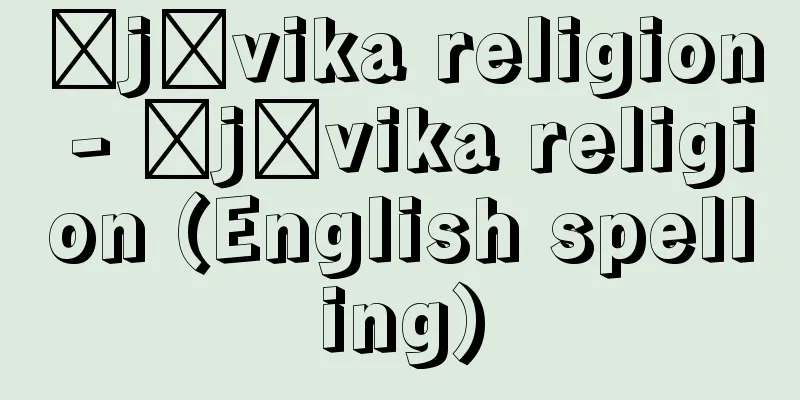

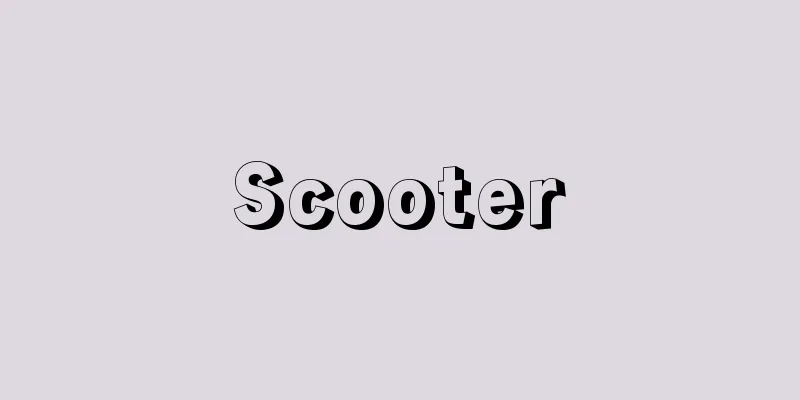
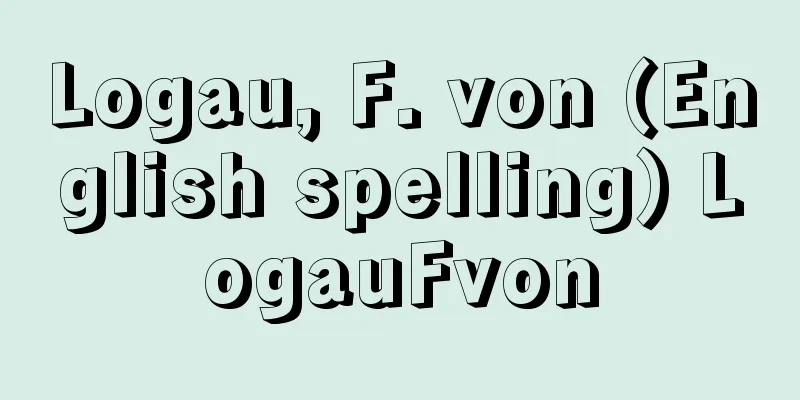
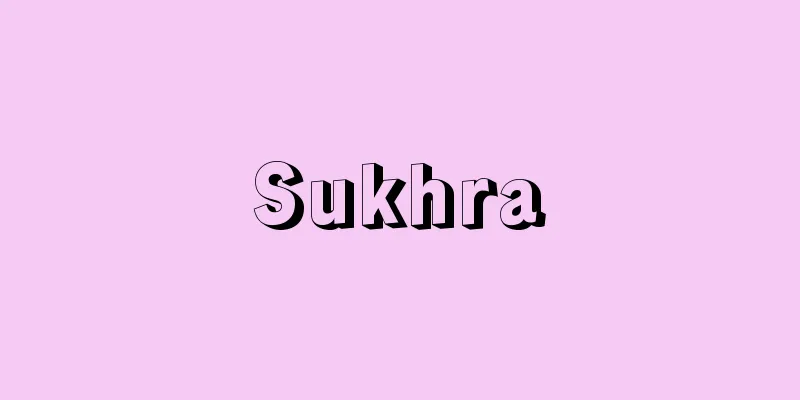
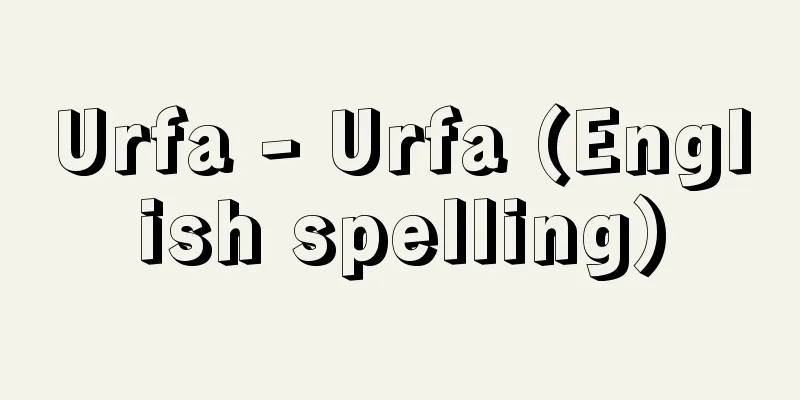

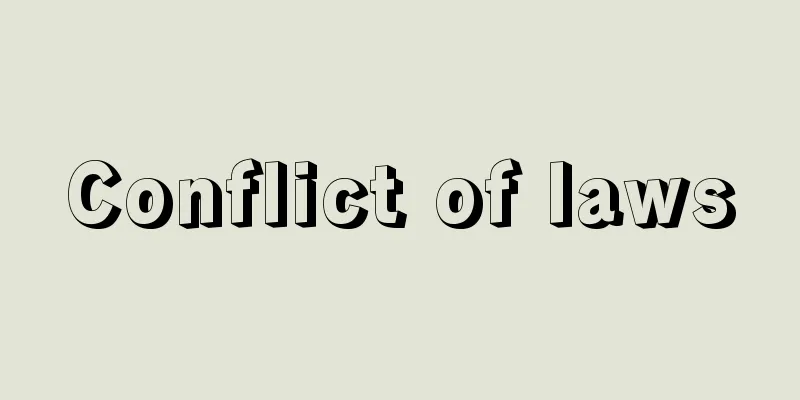
![Fukuchi [village] - Fukuchi](/upload/images/67ccb08cdae20.webp)
